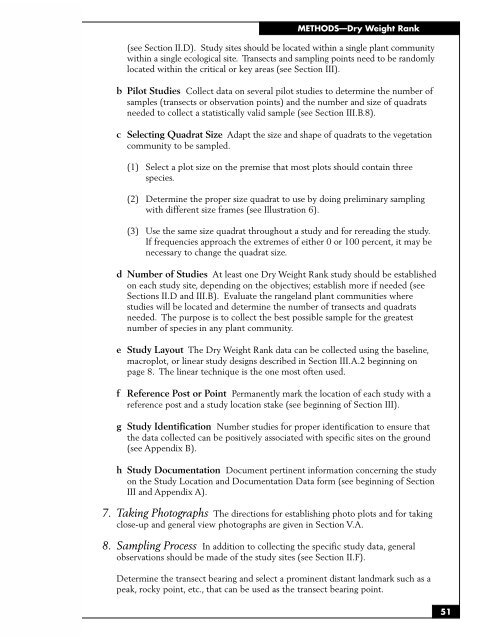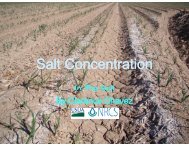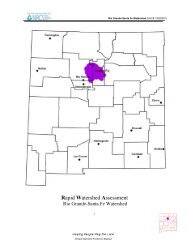SAMPLING VEGETATION ATTRIBUTES - New Mexico NRCS - US ...
SAMPLING VEGETATION ATTRIBUTES - New Mexico NRCS - US ...
SAMPLING VEGETATION ATTRIBUTES - New Mexico NRCS - US ...
You also want an ePaper? Increase the reach of your titles
YUMPU automatically turns print PDFs into web optimized ePapers that Google loves.
METHODS—Dry Weight Rank<br />
(see Section II.D). Study sites should be located within a single plant community<br />
within a single ecological site. Transects and sampling points need to be randomly<br />
located within the critical or key areas (see Section III).<br />
b Pilot Studies Collect data on several pilot studies to determine the number of<br />
samples (transects or observation points) and the number and size of quadrats<br />
needed to collect a statistically valid sample (see Section III.B.8).<br />
c Selecting Quadrat Size Adapt the size and shape of quadrats to the vegetation<br />
community to be sampled.<br />
(1) Select a plot size on the premise that most plots should contain three<br />
species.<br />
(2) Determine the proper size quadrat to use by doing preliminary sampling<br />
with different size frames (see Illustration 6).<br />
(3) Use the same size quadrat throughout a study and for rereading the study.<br />
If frequencies approach the extremes of either 0 or 100 percent, it may be<br />
necessary to change the quadrat size.<br />
d Number of Studies At least one Dry Weight Rank study should be established<br />
on each study site, depending on the objectives; establish more if needed (see<br />
Sections II.D and III.B). Evaluate the rangeland plant communities where<br />
studies will be located and determine the number of transects and quadrats<br />
needed. The purpose is to collect the best possible sample for the greatest<br />
number of species in any plant community.<br />
e Study Layout The Dry Weight Rank data can be collected using the baseline,<br />
macroplot, or linear study designs described in Section III.A.2 beginning on<br />
page 8. The linear technique is the one most often used.<br />
f Reference Post or Point Permanently mark the location of each study with a<br />
reference post and a study location stake (see beginning of Section III).<br />
g Study Identification Number studies for proper identification to ensure that<br />
the data collected can be positively associated with specific sites on the ground<br />
(see Appendix B).<br />
h Study Documentation Document pertinent information concerning the study<br />
on the Study Location and Documentation Data form (see beginning of Section<br />
III and Appendix A).<br />
7. Taking Photographs The directions for establishing photo plots and for taking<br />
close-up and general view photographs are given in Section V.A.<br />
8. Sampling Process In addition to collecting the specific study data, general<br />
observations should be made of the study sites (see Section II.F).<br />
Determine the transect bearing and select a prominent distant landmark such as a<br />
peak, rocky point, etc., that can be used as the transect bearing point.<br />
51




